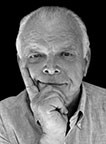

Photographer Bob Adelman
Biography adapted from the the New York Times Lens Blog and Bob Adelman's home page.
American, born 1930, died March 2016.
Bob Adelman came to a distinguished career in photography through the back door. After a childhood in Brooklyn – the child of Eastern European immigrants – Adelman got a B.A. from Rutgers, studied law for a time at Harvard, and got a Masters degree in philosophy from Columbia. In graduate school, he grew tired of "what's-the-purpose-of-life" courses and turned to aesthetics, the philosophy of art. Adelman's father had been an amateur photographer and a master craftsman who worked on renovating the floors in the White House during Truman's administration. So, it's not surprising that the son moved from studying art to making art through photographs.
In college, Adelman discovered the socially-aware photographs of Lewis Hine, Dorothea Lange, Walker Evans and W. Eugene Smith, and he turned his camera on similar subject matter. He built a career as a full-time freelance photographer covering civil rights, poverty, mental illness, alcoholism, inadequate housing, immigration, prostitution, illiteracy and other issues. As the civil rights issue heated up in the 1960s, he volunteered his services to the CORE, the Congress of Racial Equality, and SNCC, known as "SNICK," the Student Nonviolent Coordinating Committee. Because he wasn't working for a breaking news organization, he had the time to look for the moments the explained the movement. "I think my pictures were different than those of others," he says, "because I wasn't just covering the events... Being part of the Civil Rights Movement was like being in a war zone – the last battle of the American Civil War. I shot with one eye on the lense, one eye on history, and my heart with the Movement."
Adelman knew his professional choice brought danger. "For me to get involved in something, I had to see some purpose to it and it had to mean something. Segregation was an organized system of terror enforced by the Klan. I realized my involvement would be very dangerous, but I had a long think with myself and decided that this was something worth risking your life for."
In 1963, Adelman was at the children's demonstrations when the dogs and high-pressure firehoses came out to terrorize the marchers. Adelman hid behind a tree and photographed some of the most compelling images of the civil rights struggle. Legendary educator and magazine designer Alexey Brodovitch ranked Adelman's photos at Birmingham as the best he saw in 1963.
To wind down from assignments of the demonstrations, Adelman would return home to New York and attended gallery openings for contemporary artists like Andy Warhol, Larry Rivers, James Rosenquist and Roy Lichtenstein. He produced photos and books with several of the artists.
Adelman had a long career photographing for LOOK, Life, and the New York Times. He has photographed and/or edited over 50 books. He received grants from the Guggenheim Fellowships and the National Endowment for the Arts. He has awards from the University of Missouri School of Journalism, the American Institute of Graphic Arts, and the Art Director's Clubs of New York, Washington, and San Francisco. He has taught photography at the International Center for Photography, The New School, the School of Visual Arts and a dozen others. His work is in the collections of the Museum of Modern Art, the Getty Museum, the Hallmark Collection and private collections.
He lives and still works in Miami Beach.
Selected Books: Bob Adelman has been involved in the production of over 50 books. These are a few that feature his photographs.
- 1972, Down Home: Camden Alabama
- 1972, Street Smart: Adventures from the Lives of Children, with text by Susan Hall
- 1973 & 2006, Gentlemen of Leisure, with text by Susan Hall
- 1973, Ladies of the Night, with text by Susan Hall
- 1976, Out of Left Field: Willie Stargell and the Pittsburgh Pirates
- 1980, On and Off the Street, with text by Susan Hall
- 1981, The Next America: The Decline and Rise of the United States, with text by Michael Harrington
- 1984, The Reagan Report
- 1987, Art Of Roy Lichtenstein: Mural With Blue Brushstroke, with commentary by Calvin Tompkins
- 1990, Carver Country: The World of Raymond Carver, introduction by Tess Gallagher
- 1991, Visions of Liberty: The Bill of Rights For All Americans, text by Ira Glasser
- 2000, King: The Photobiography of Martin Luther King Jr., text by Charles Johnson
